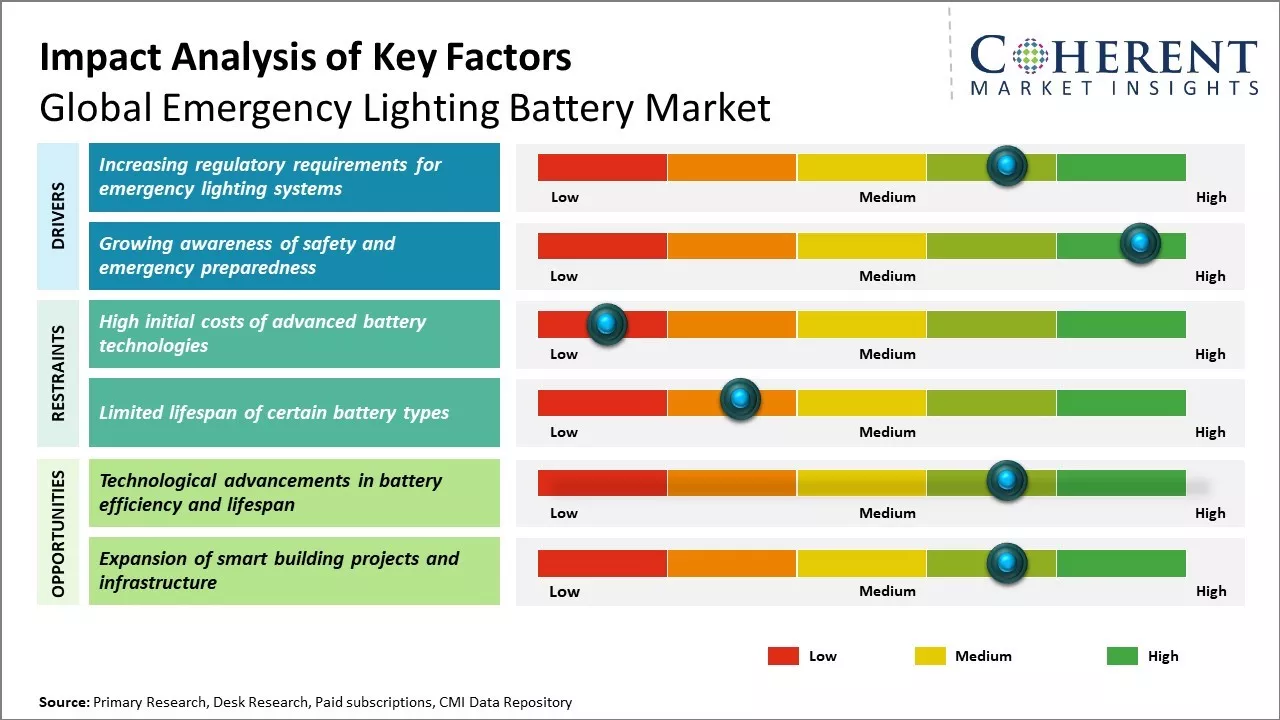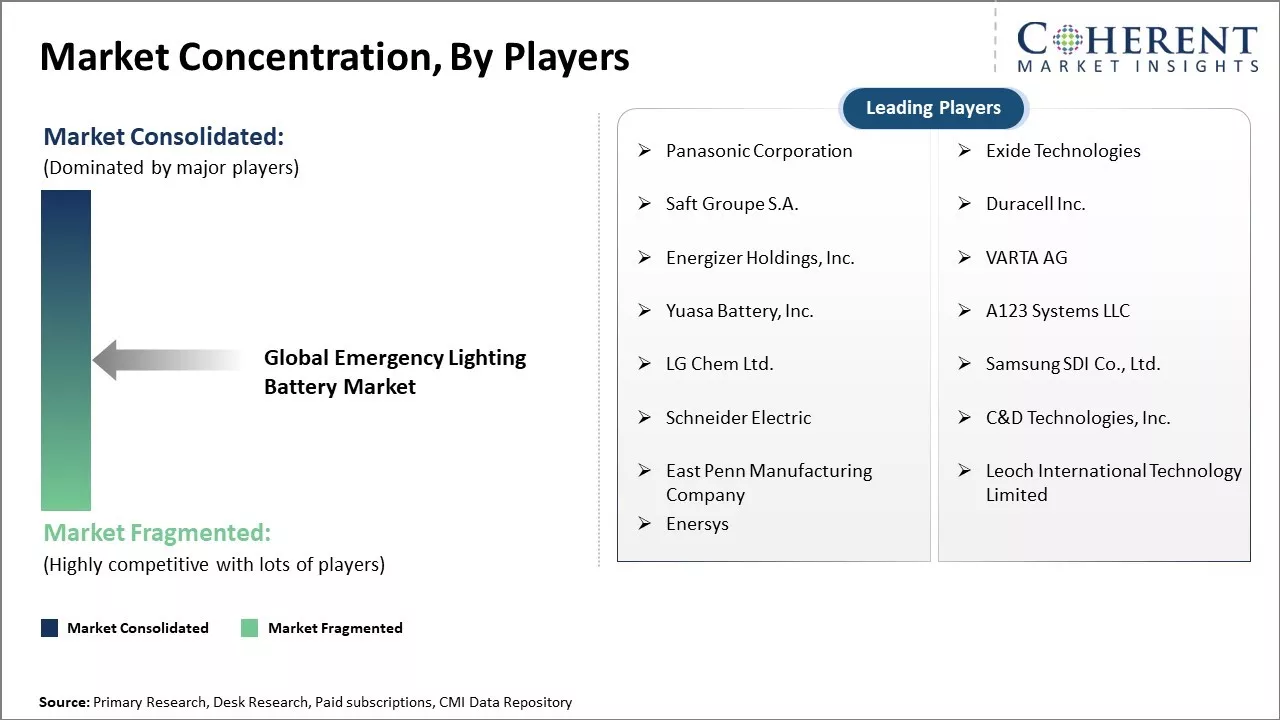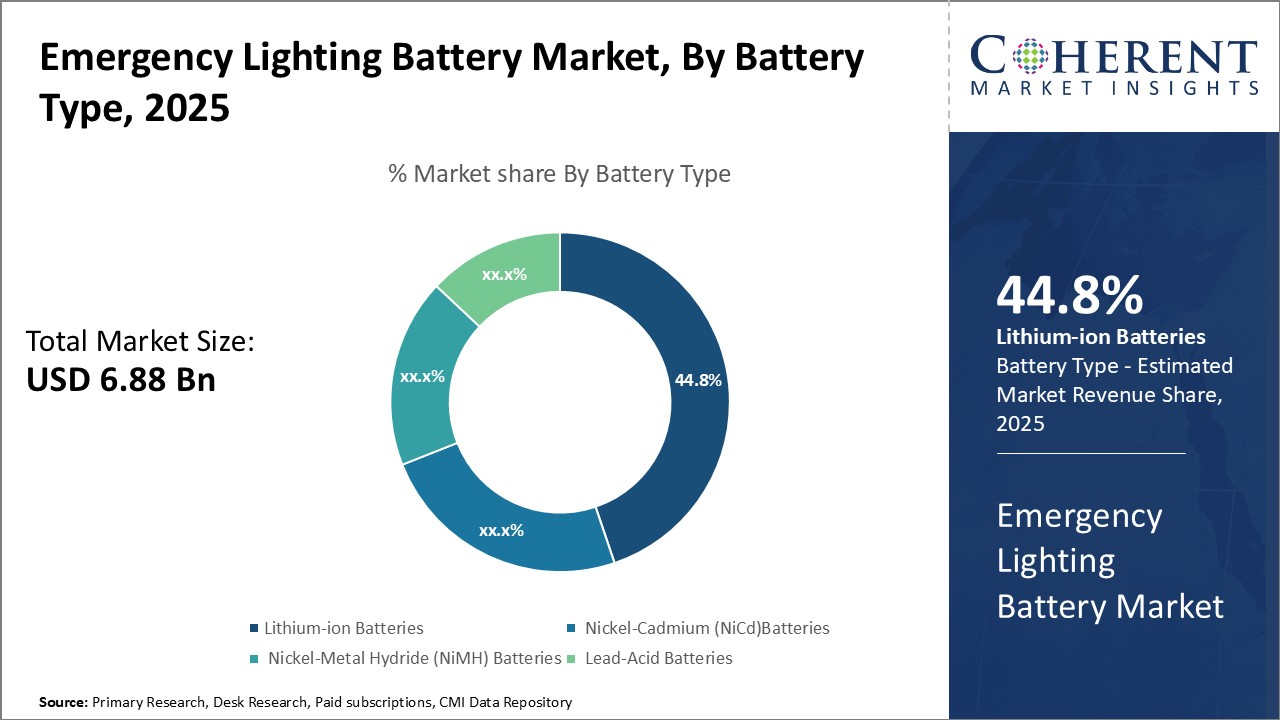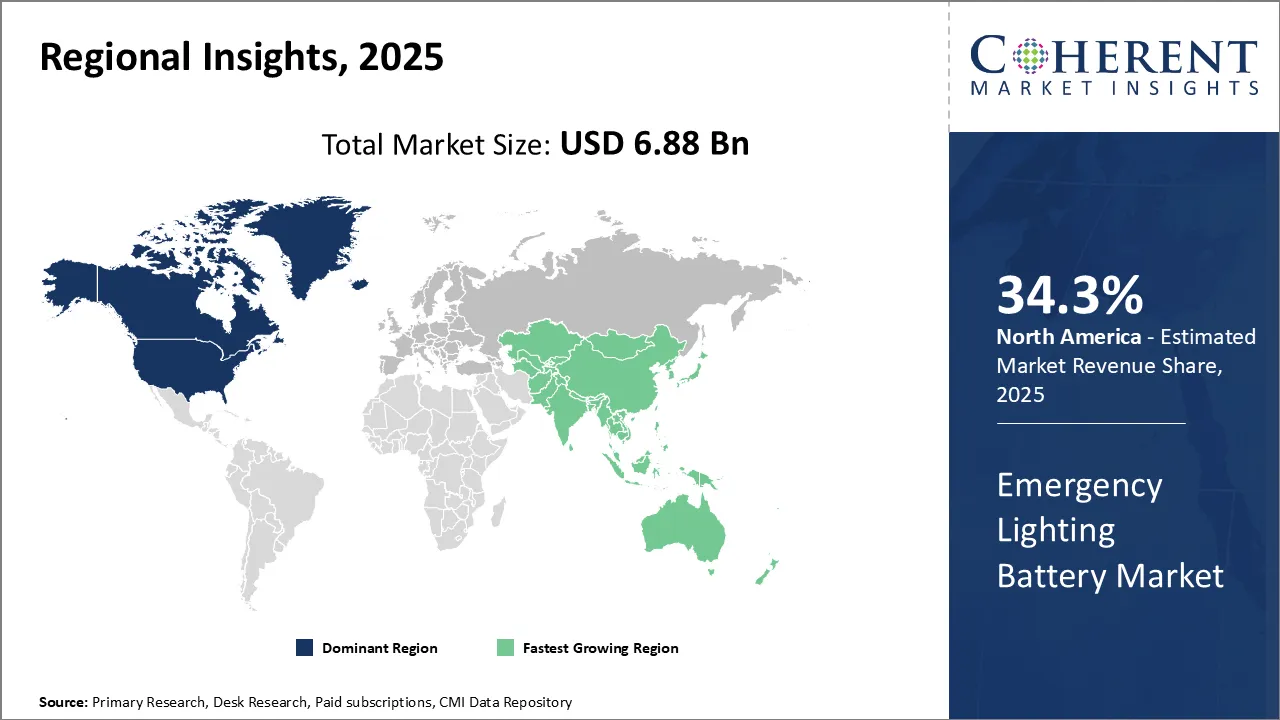Global emergency lighting battery market is estimated to be valued at US$ 6.88 Bn in 2025 and is expected to reach US$ 10.56 Bn by 2032, exhibiting a compound annual growth rate (CAGR) of 6.3% from 2025 to 2032.

Discover market dynamics shaping the industry: Request sample copy
The Global Emergency Lighting Battery Market has been experiencing steady growth owing to stringent government regulations regarding implementation of emergency lighting systems across various industries.
Emergency lighting batteries are increasingly being adopted across industries such as oil & gas, healthcare, commercial buildings, and others due to mandatory fire and safety compliance protocols. Lithium-ion batteries have been gaining popularity as an efficient emergency lighting solution due to benefits such as high energy density, longer life, fast recharge time, and lower self-discharge rate when compared to traditional battery types. Advancing lithium-ion battery technologies, widening applications in critical infrastructure, and the need for robust emergency backup protocols during power outages are some key factors fueling growth in the global emergency lighting battery market.
Market Driver - Increasing regulatory requirements for emergency lighting systems
Strict government regulations surrounding workplace and building safety have driven increased adoption of emergency lighting systems globally. Most developed countries now have laws requiring specific types of facilities like hospitals, schools, commercial buildings and manufacturing plants to have emergency lighting installed. This is intended to ensure occupants can safely evacuate in the event of a power outage or fire. Emergency lighting allows staff to guide patients, students and visitors to exits even without main power. Harsher penalties for non-compliance have also motivated owners to upgrade their existing lights or install new battery-backed systems.
Government mandates often specify the number and location of emergency lights as well as minimum performance standards for luminance, operation duration and self-testing. For example, the National Fire Protection Association in the U.S. requires lights in exit corridors and exit stairwells to provide sufficient illumination for people to safely maneuver in an evacuation. The lighting must remain operational for at least 90 minutes from the time of a power failure. Similarly, the European Committee for Standardization' regulations demand that emergency lighting illuminate evacuation routes and fire equipment at all times. They also prescribe detailed tests to validate battery longevity and recharging ability.
Stricter safety laws have especially impacted high-risk sectors like energy facilities, factories, transportation hubs and large public venues that accommodate mass gatherings. The catastrophic consequences of system failure during emergencies in these environments have led authorities to tighten rules governing emergency power backup. Overall, the need for buildings and their occupants to be compliant with evolving safety norms has driven consistent investment in upgraded emergency lighting solutions with enhanced reliability.

Get actionable strategies to beat competition: Request sample copy
Growing awareness of safety and emergency preparedness
In recent years, consumer awareness of safety issues and emergency planning has increased significantly. High-profile disasters around the world, whether natural calamities or human-made, have highlighted the vital importance of emergency preparedness. Devastating hurricanes, wildfires and other extreme weather events are also raising concerns about power outages and their consequences. There is a growing realization that every home, community and business needs to have adequate backup systems in place to deal with unexpected emergencies. Reliable emergency lights that switch on automatically in a power cut are seen as an essential part of being prepared.
Additionally, greater dissemination of safety knowledge through various awareness campaigns by NGOs and government agencies has educated people about steps to take before, during and after crisis situations. Popular work safety programs by industry groups and educational institutes are also stressing the value of fully-functional emergency backup solutions. This is driving demand for robust, long-lasting emergency lighting not just in offices and factories but also residences. Individuals now recognize lights that guide evacuation as a basic requirement, alongside other preparedness gear like emergency food/water supplies and first aid kits.
The COVID-19 pandemic in particular heightened alertness about the need for crowd management and social distancing measures during emergencies. This boosted interest in intelligent, networked emergency lighting systems with controls for remote operation and monitoring of evacuation routes. With natural disasters intensifying due to climate change and the threat of unforeseen crises always looming, safety experts expect awareness of emergency preparedness to grow steadily, propelling market opportunities.
Key Takeaways from Analyst:
Global emergency lighting battery market is poised to experience steady growth driven by stringent safety regulations across industries regarding emergency lighting, demand for backup batteries will continue rising. Lithium-ion battery technology is gaining widespread acceptance fueled by its higher energy density and longer lifespan vis-à-vis traditional chemistries. North America currently dominates market revenues supported by strong building safety codes in the U.S. and Canada. However, Asia Pacific is predicted to emerge as the fastest growing regional market given extensive infrastructure development and expanding manufacturing activity in China and India.
While regulatory push will propel market opportunities, high initial installation costs remain a key challenge to be addressed. Focus on cost-effective, long-lasting and efficient energy storage solutions is expected to open new avenues for battery manufacturers. Furthermore, demand from the telecom industry for reliable off-grid lighting during power outages opens an overlooked sector for emergency batteries. Rising adoption of LED lighting is another driver as they require lower energy batteries as replacements. Innovation in lightweight, compact batteries integrated with LED drivers can unlock untapped potential.
Although developed markets still account for the bulk of sales, developing economies in Latin America and Middle East & Africa are gaining attention of global industry players.
Market Challenge - High initial costs of advanced battery technologies
Global emergency lighting battery market is currently being hindered by the high initial costs associated with newer advanced battery technologies. Transitioning to more advanced batteries like lithium-ion or nickel-cadmium batteries requires significant capital investments from businesses as the upfront costs of these batteries are much higher compared to conventional battery types. The payback period for such investments is also longer. This high upfront expenditure poses a major challenge for the adoption of advanced batteries, especially for small and medium enterprises with constrained capital budgets. Additionally, the advanced batteries are also more expensive to procure compared to lead-acid batteries which remain the standard choice for many due to their relatively low costs. Unless the costs of newer battery technologies come down significantly, it will be difficult for their widespread use in the emergency lighting market.
For instance, In August 2021, Saft Groupe S.A., a leading French manufacturer specializing in advanced battery technologies for industrial applications, announced its acquisition of a battery technology firm to enhance its product portfolio. This strategic move aims to bolster Saft's capabilities in developing innovative battery solutions, particularly in the growing sectors of renewable energy and electric mobility.
Market Opportunities - Technological advancements in battery efficiency and lifespan
One of the key opportunities for the global emergency lighting battery market lies in the ongoing technological advancements that are improving the efficiency and lifespan of different battery varieties. Innovation in materials, chemistries and manufacturing processes are enabling battery companies to develop solutions that store more energy, last longer and charge faster. For instance, the latest lithium-ion batteries now provide up to 3 times more energy density and life compared to earlier variants. Similarly, recent innovations are extending the useful life of nickel-cadmium batteries as well. Such continuous performance enhancements are expected to boost the uptake of advanced batteries as they provide higher value proposition over the long run through lower daily operating costs despite higher upfront costs. Overall, further battery innovation will be critical for unlocking the full market potential.

Discover high revenue pocket segments and roadmap to it: Request sample copy
By Battery Type - Battery Superiority Drives Lithium-ion Dominance
In terms of battery type, the lithium-ion batteries segment is estimated to contribute the highest market share of 44.8% in 2025 owing to its technical advantages over alternatives. Lithium-ion batteries offer higher energy density compared to lead-acid or NiCd batteries, meaning they can power lights for longer periods of time in an emergency situation from a smaller physical battery size. This allows emergency lighting products using lithium batteries to be more compactly designed while still meeting runtime requirements. Lithium batteries also suffer less from the memory effect that plagues NiCd batteries, requiring fewer charge/discharge cycles to reach maximum capacity.
Lithium batteries also have a longer service life, with a cycle life 1.5-2 times greater than lead-acid or NiMH batteries. This reduces operating and replacement costs for facilities over the lifetime use of emergency lights. There is no risk of liquids leaks either, making lithium designs safer. The lack of scheduled battery replacements also means less disruption and labor costs associated with maintenance. Advanced lithium chemistries also have very low self-discharge rates, retaining a charge for up to ten years without needing to recharge if not in use. This gives emergency lights relying on lithium power assurance they will work in an outage even if not routinely tested.
The chemistry of lithium ions also gives them a flat discharge curve, maintaining voltage levels close to full capacity right up until they are almost drained. This ensures lights powered by lithium will burn at full brightness throughout a blackout situation until the very end, unlike competitors whose light output fades as batteries discharge. For critical life safety applications, the consistent performance of lithium is a key attribute driving its popularity. Ongoing reductions in lithium battery costs are also making them increasingly price competitive versus other technologies used in emergency lighting solutions.
For instance, In March 2021, Panasonic, a global leader in battery technology and energy solutions, introduced a new line of lithium-ion batteries specifically designed for emergency lighting applications. This innovative product line aims to enhance the reliability and efficiency of emergency lighting systems, ensuring that critical areas remain illuminated during power outages or emergencies.
By Application - Commercial Dominance Drives Through Compliance
In terms of application, the commercial segment is estimated to contribute the highest market share of 37.6% in 2025 due to rigorous life safety standards that must be met. All commercial buildings are required by code to have illuminated emergency signage and egress lighting. Additionally, facilities like hospitals, schools and large retailers typically have sophisticated emergency lighting systems to guide occupants to safety zones in the event of power failures. Compliance with building and fire codes is crucial to businesses seeking occupancy permits and avoiding penalties. As a result, commercial properties prioritize high-quality emergency lighting products to adhere to mandates.
Many commercial facilities operate for extended hours and require robust, long-lasting emergency fixtures that provide reliable backup lighting. The consistent performance and longevity of lithium battery-powered systems, which dominate the commercial segment, meets these needs cost-effectively versus alternatives with more maintenance requirements. Large commercial facilities also have many more emergency fixtures than a typical home, representing a major capital expenditure that owners try to maximize through durable, low-maintenance designs. Commercial architects additionally specify trusted brands proven through rigorous testing standards to minimize life safety risks and liability issues. These factors drive commercial customers to prefer premium battery technologies like lithium.
By End User - Safety Compliance Drives Retail Sector
In terms of end user, the retail segment is estimated to contribute the highest market share of 42.3% in 2025 owing to the sector's focus on safety compliance. Retailers operate facilities that welcome large numbers of customers every day, creating crowded conditions during peak hours and evacuation challenges in emergencies. Proper emergency lighting is mission-critical to safely guide customers, especially families with children, to exits in periods of darkness caused by power outages. Retailers recognize that minimizing safety risks and avoiding liability issues is imperative to protecting their brand reputation and avoiding costly law suits.
Many retail locations like big box stores, shopping malls and grocery chains have sprawling footprints with expansive inventory storage areas not regularly accessed by customers. Code-compliant emergency lighting must illuminate all paths of egress, even remote sections of these massive facilities. The long runtimes and low maintenance needs of lithium battery technologies, which have majority retail market share, satisfy these demanding requirements versus competitors. Centralized monitoring of emergency lighting also allows retail security to spot partial system outages needing attention to head off potential safety hazards before issues arise. With profit margins thin, retailers further prioritize emergency lighting solutions optimized for lifecycle cost and reliability to maximize return on safety investments. These factors drive premier adoption within the vital retail end user segment.

Need a Different Region or Segment? Customize now
North America has emerged as the dominant region in the global emergency lighting battery market with 34.3% share in 2025. The U.S. being a manufacturing powerhouse with industries like oil & gas, healthcare, and data centers requires robust emergency backup solutions to avoid production losses during power outages. Moreover, organizations in the U.S. prefer locally sourcing equipment and solutions due to economic and supply chain advantages over imported goods. This reduces import dependence and establishes North America as the hub for high-quality emergency lighting batteries.
The Asia Pacific region is witnessing the fastest growth and shows promising signs to dominate future markets. Rapid industrialization and infrastructure development across China, India, Japan, and Southeast Asian nations are driving large-scale investments in emergency equipment catering to factories, plants, buildings, transportation, and public utilities. Population density and proliferation of multinationals in the region are strengthening the business case for safety compliance during disasters and calamities. With over 60.5% of global population residing in the Asia Pacific, even marginally higher per capita spending on battery-operated emergency lights translates into substantial revenues. Strong expertise in manufacturing lithium and lead-acid batteries due to a large consumer electronics industry also positions regional players to capture the opportunities. Several Chinese and Korean enterprises are aggressively expanding by acquiring foreign brands and setting up local production units at lower costs to target broad audiences. This has provided Asia Pacific an edge in the emergency lighting battery realm and accelerated its position as a swiftly emerging market.
Emergency Lighting Battery Market Report Coverage
| Report Coverage | Details | ||
|---|---|---|---|
| Base Year: | 2024 | Market Size in 2025: | USD 6.88 Bn |
| Historical Data for: | 2020 To 2024 | Forecast Period: | 2025 To 2032 |
| Forecast Period 2025 to 2032 CAGR: | 6.3% | 2032 Value Projection: | USD 10.56 Bn |
| Geographies covered: |
|
||
| Segments covered: |
|
||
| Companies covered: |
Panasonic Corporation, Exide Technologies, Saft Groupe S.A., Duracell Inc., Energizer Holdings, Inc., VARTA AG, Yuasa Battery, Inc., A123 Systems LLC, LG Chem Ltd., Samsung SDI Co., Ltd., Schneider Electric, C&D Technologies, Inc., East Penn Manufacturing Company, Leoch International Technology Limited, and Enersys |
||
| Growth Drivers: |
|
||
| Restraints & Challenges: |
|
||
Uncover macros and micros vetted on 75+ parameters: Get instant access to report
Share
Share
About Author
As an accomplished Senior Consultant with 7+ years of experience, Pooja Tayade has a proven track record in devising and implementing data and strategy consulting across various industries. She specializes in market research, competitive analysis, primary insights, and market estimation. She excels in strategic advisory, delivering data-driven insights to help clients navigate market complexities, optimize entry strategies, and achieve sustainable growth.
Missing comfort of reading report in your local language? Find your preferred language :
Transform your Strategy with Exclusive Trending Reports :
Frequently Asked Questions
Joining thousands of companies around the world committed to making the Excellent Business Solutions.
View All Our Clients
US Reciprocal Tax Impact Analysis On Emergency Lighting Battery Market
Stay updated on tariff changes with expert insights and timely information